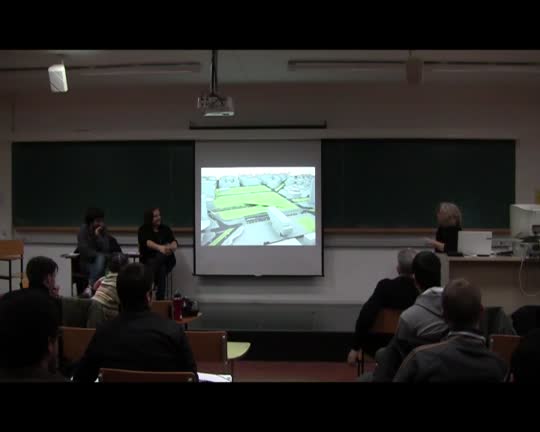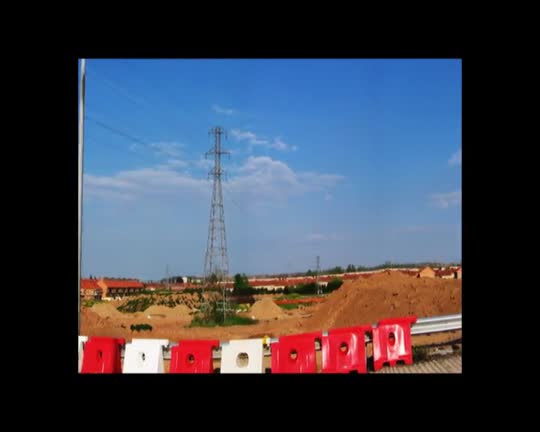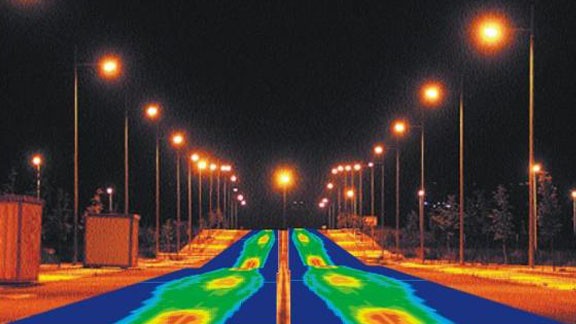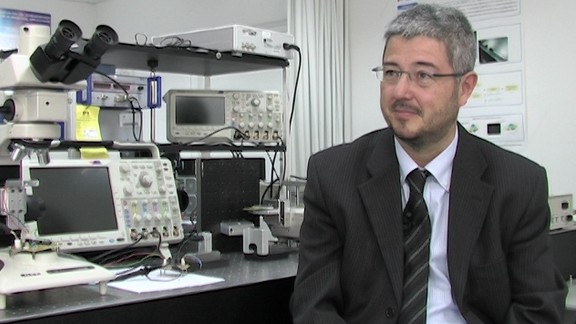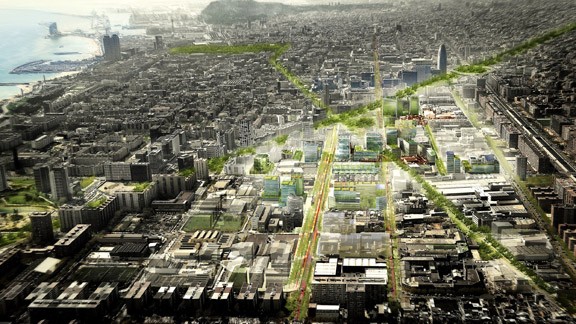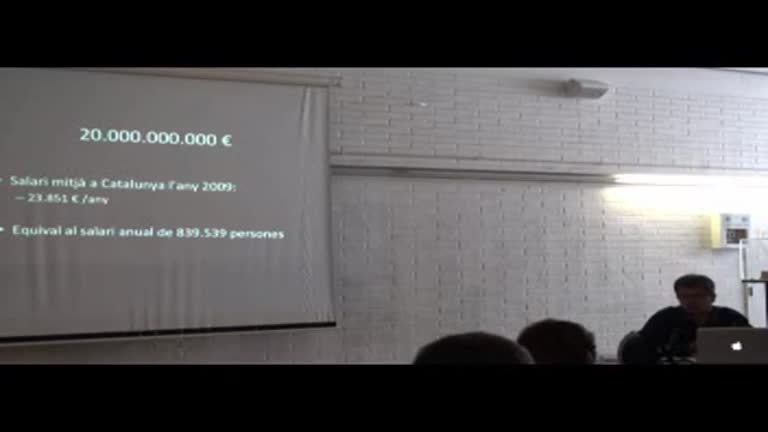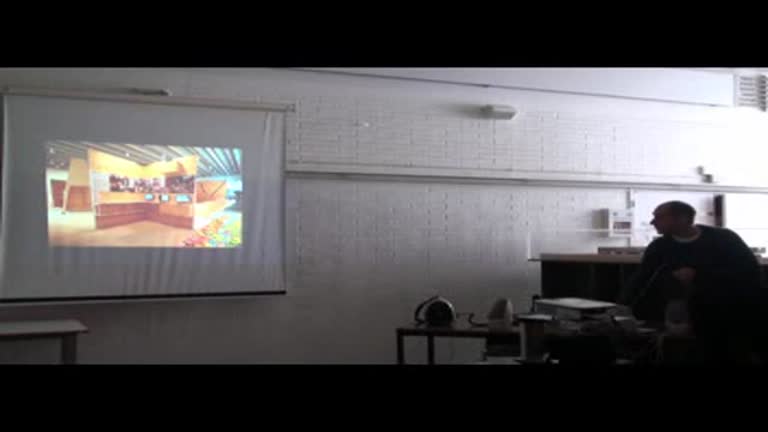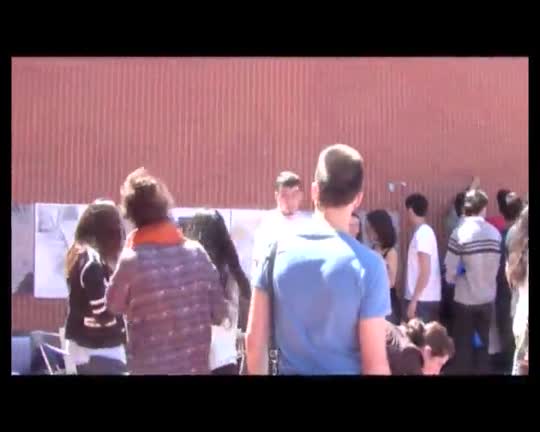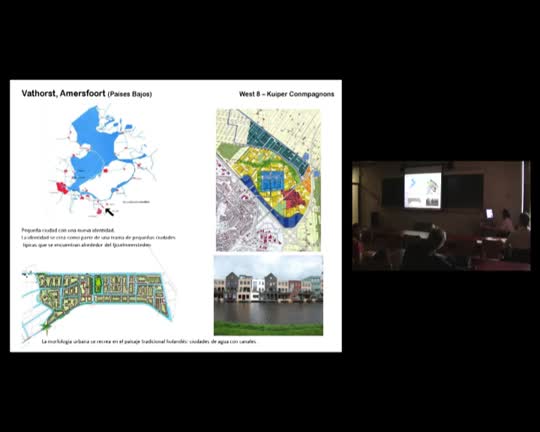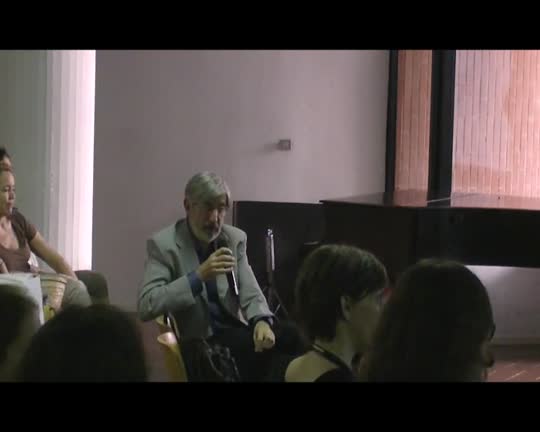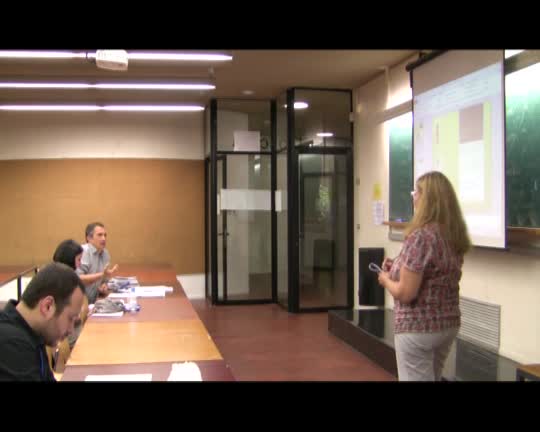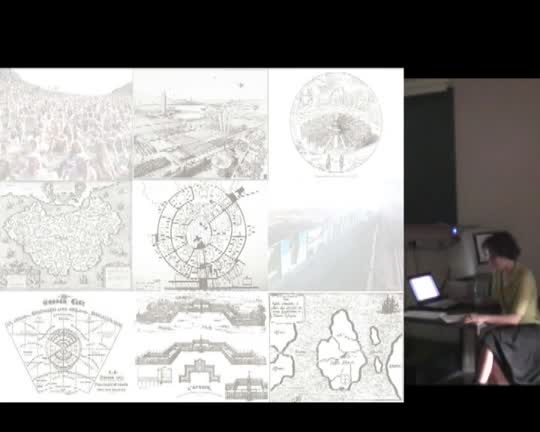Objectes multimèdia amb l’etiqueta: Urbanisme
Resultats de la cerca
Debat sobre la transformació de les Glòries
Accés obert
27 de nov. 2013
Debat sobre la transformació de Les Glòries amb els experts del tema i seleccionats del concurs internacional.
POSTsuburbia
Accés obert
12 de nov. 2013
Presentació del documental i el llibre de la recerca a càrrec de Zaida Muxí (DUOT-ETSAB).
Sensors òptics a les smarts cities
Accés obert
11 de nov. 2013
L’any 2050 el 70 % de la població mundial viurà en ciutats: aquest escenari fa imprescindible plantejar nous models de gestió urbana més sostenibles i eficients. És el propòsit de les anomenades ‘smart cities’ o 'clever cities', una expressió que s’aplica a les ciutats compromeses en una gestió més automàtica i eficient de les seves infraestructures i serveis.
Barcelona lidera la creació del primer protocol de ciutats intel·ligents de tot el món i acull la trobada mundial de ciutats intel·ligents, la Smart City Expo World Congress, que se celebra la propera setmana, del 19 al 21 de novembre. És l’aposta per un nou model de ciutat al qual la UPC aporta solucions tecnològiques innovadores en àrees tan diverses i interdisciplinàries com l’electrònica, la informàtica, la telemàtica, la robòtica, la computació, l’eficiència energètica, la mobilitat i el transport, la planificació urbanística i l’edificació sostenible o bé el medi ambient.
Aconseguir l’eficiència energètica és un dels objectius d’una smart city: amb el propòsit de reduir la despesa de l’excés de consum d’il·luminació de les ciutats, investigadors de la UPC han desenvolupat una nova tecnologia per mesurar l’enllumenat urbà. Es tracta d’un dispositiu fotomètric mòbil que s’instal·la a qualsevol vehicle i que avalua la qualitat i quantitat de llums dels carrers, cosa que fa possible que les ciutats puguin regular l’enllumenat urbà en funció del moment i de l’ús. Per aconseguir-ho, múltiples sensors òptics són capaços de captar i proporcionar una gran informació en l'àmbit de la il·luminació, tal i com ens expliquen Santiago Royo i Carles Pizarro, investigadors del Centre de Desenvolupament de Sensors, Instrumentació i Sistemes (CD6) de la UPC.
Barcelona lidera la creació del primer protocol de ciutats intel·ligents de tot el món i acull la trobada mundial de ciutats intel·ligents, la Smart City Expo World Congress, que se celebra la propera setmana, del 19 al 21 de novembre. És l’aposta per un nou model de ciutat al qual la UPC aporta solucions tecnològiques innovadores en àrees tan diverses i interdisciplinàries com l’electrònica, la informàtica, la telemàtica, la robòtica, la computació, l’eficiència energètica, la mobilitat i el transport, la planificació urbanística i l’edificació sostenible o bé el medi ambient.
Aconseguir l’eficiència energètica és un dels objectius d’una smart city: amb el propòsit de reduir la despesa de l’excés de consum d’il·luminació de les ciutats, investigadors de la UPC han desenvolupat una nova tecnologia per mesurar l’enllumenat urbà. Es tracta d’un dispositiu fotomètric mòbil que s’instal·la a qualsevol vehicle i que avalua la qualitat i quantitat de llums dels carrers, cosa que fa possible que les ciutats puguin regular l’enllumenat urbà en funció del moment i de l’ús. Per aconseguir-ho, múltiples sensors òptics són capaços de captar i proporcionar una gran informació en l'àmbit de la il·luminació, tal i com ens expliquen Santiago Royo i Carles Pizarro, investigadors del Centre de Desenvolupament de Sensors, Instrumentació i Sistemes (CD6) de la UPC.
Smart cities: reptes del sector
Accés obert
11 de nov. 2013
Smart city - ciutat intel·ligent - és el terme que defineix un nou model de ciutat que integra iniciatives orientades a millorar la qualitat de vida de les persones i que dóna resposta als nous reptes de la ciutat en àmbits com la gestió d'infraestructures, la salut i els serveis socials, l'energia, la mobilitat urbana, la sostenibilitat mediambiental o la governança, i que utilitza de manera intensiva les tecnologies de la informació i la comunicació (TIC).
La implementació i el desenvolupament de projectes de smart cities és complex: requereixen una visió transversal i integrada, així com la transformació de moltes infraestructures i serveis de la ciutat, i dels seus models de gestió, tal i com ens explica Santiago Royo, director del Centre de Desenvolupament de Sensors, Instrumentació i Sistemes (CD6) de la UPC.
La implementació i el desenvolupament de projectes de smart cities és complex: requereixen una visió transversal i integrada, així com la transformació de moltes infraestructures i serveis de la ciutat, i dels seus models de gestió, tal i com ens explica Santiago Royo, director del Centre de Desenvolupament de Sensors, Instrumentació i Sistemes (CD6) de la UPC.
Què són les smart cities?
Accés obert
9 de nov. 2013
La propera setmana se celebra a Barcelona la Smart City Expo World Congress, un saló que reunirà els experts i les empreses líders en iniciatives innovadores sobre la ciutat del futur. Què significa ser una smart city?
Les smarts cities o ciutats intel·ligents són una primera implementació de la futura ‘Internet de les coses’, un concepte que implica que tant persones com objectes puguin connectar-se a la xarxa en qualsevol moment i lloc. Es tracta de captar, transportar i reaccionar de forma sofisticada a través de sistemes intel·ligents. Per aconseguir-ho, múltiples sensors són capaços de captar i proporcionar una gran informació. Milions de dispositius es connecten a través de diferents xarxes de comunicació a centres de monitoratge que permeten l’anàlisi i la gestió de dades i faciliten la presa de decisions i la prestació de serveis als ciutadans. És l’anomenada 'sensorització de les ciutats', tal i com ens explica Josep Paradells, professor del Departament d’Enginyeria Telemàtica de la UPC.
Les smarts cities o ciutats intel·ligents són una primera implementació de la futura ‘Internet de les coses’, un concepte que implica que tant persones com objectes puguin connectar-se a la xarxa en qualsevol moment i lloc. Es tracta de captar, transportar i reaccionar de forma sofisticada a través de sistemes intel·ligents. Per aconseguir-ho, múltiples sensors són capaços de captar i proporcionar una gran informació. Milions de dispositius es connecten a través de diferents xarxes de comunicació a centres de monitoratge que permeten l’anàlisi i la gestió de dades i faciliten la presa de decisions i la prestació de serveis als ciutadans. És l’anomenada 'sensorització de les ciutats', tal i com ens explica Josep Paradells, professor del Departament d’Enginyeria Telemàtica de la UPC.
Intravention, Durations, Effects, Notes of Expansive Sites and Relational Architectures
Accés obert
1 de nov. 2013
La Ciutat per parts. Accions al darrer Tram del Besós
Accés obert
1 de jul. 2013
Exposició de materials de l'Assignatura Urbanistica II Matins de Maria Rubert de Ventós.
Línia de Investigación: Análisis y Ordenación del Paisaje. Readers: Pere Valls y Miquel Vidal
Accés obert
16 de juny 2013
Sessió paral·lela. Línia d'Investigació "Anàlisi i Ordenació del Paisatge". Readers: Pere Vall, UIC i Miquel Vidal, DUOT-ETSAB. Intervenen en aquest ordre (vegeu títols alternatius de les presentacions): Catalina Salvà; Cristina del Pozo i Silvia Segura.
Barcelona, 13 y 14 de junio de 2013. Buenos Aires, 27 y 28 de junio de 2013. Institucions organitzadores: Departament d'Urbanisme i Ordenació del Territori. Universitat Politècnica de Catalunya, Instituto del Conourbano. Universidad Nacional del General Sarmiento, Instituto de Arte Americano. Universidad de Buenos Aires.
Barcelona, 13 y 14 de junio de 2013. Buenos Aires, 27 y 28 de junio de 2013. Institucions organitzadores: Departament d'Urbanisme i Ordenació del Territori. Universitat Politècnica de Catalunya, Instituto del Conourbano. Universidad Nacional del General Sarmiento, Instituto de Arte Americano. Universidad de Buenos Aires.
Conferencia Plenaria y de Clausura del V Seminario Internacional de Investigación en Urbanismo
Accés obert
14 de juny 2013
Conferències Plenària i de Clausura del Seminari celebrats a la Sala d'actes de l'ETSAB a càrrec de la Dra Alicia Novick, Arquitecta (Facultad de Arquitectura, Diseño y Urbanismo de la Universidad de Buenos Aires -FADU-UBA), i el Dr. Antonio Font, Catedràtic del Departament d' Urbanisme i Ordenació del Territori (ETSAB-UPC). Presentats per Joaquin Sabaté, Director del Seminari (DUOT-ETSAB).
Barcelona, 13 y 14 de junio de 2013. Buenos Aires, 27 y 28 de junio de 2013. Instituciones organizadoras: Departament d'Urbanisme i Ordenació del Territori. Universitat Politècnica de Catalunya, Instituto del Conourbano. Universidad Nacional del General Sarmiento, Instituto de Arte Americano. Universidad de Buenos Aires.
Barcelona, 13 y 14 de junio de 2013. Buenos Aires, 27 y 28 de junio de 2013. Instituciones organizadoras: Departament d'Urbanisme i Ordenació del Territori. Universitat Politècnica de Catalunya, Instituto del Conourbano. Universidad Nacional del General Sarmiento, Instituto de Arte Americano. Universidad de Buenos Aires.
Línia de Investigación: Análisis y Ordenación del Paisaje. Readers: Enric Batlle i Sofia Morgado
Accés obert
14 de juny 2013
Sessió paral·lela. Línia d'Investigació "Anàlisi i Ordenació del Paisatge". Readers: Enric Batlle (DUOT-ETSAB) i Sofia Morgado, Faculdade de Arquitectura, Pólo Universitário do Alto da Ajuda, Lisboa.
Intervenen en aquest ordre (vegeu títols alternatius de les presentacions): Emilia Román; Mª Cristina Montfort; Cristina Mª Margalhaes.
Barcelona, 13 y 14 de junio de 2013. Buenos Aires, 27 y 28 de junio de 2013. Institucions organitzadores: Departament d'Urbanisme i Ordenació del Territori. Universitat Politècnica de Catalunya, Instituto del Conourbano. Universidad Nacional del General Sarmiento, Instituto de Arte Americano. Universidad de Buenos Aires.
Intervenen en aquest ordre (vegeu títols alternatius de les presentacions): Emilia Román; Mª Cristina Montfort; Cristina Mª Margalhaes.
Barcelona, 13 y 14 de junio de 2013. Buenos Aires, 27 y 28 de junio de 2013. Institucions organitzadores: Departament d'Urbanisme i Ordenació del Territori. Universitat Politècnica de Catalunya, Instituto del Conourbano. Universidad Nacional del General Sarmiento, Instituto de Arte Americano. Universidad de Buenos Aires.
Línia de Investigación: Análisis y Proyecto Territorial. Readers: Antonio Font y Xabier Eizaguirre
Accés obert
14 de juny 2013
Sessió paral·lela. Línia d'Investigació "Anàlisi i Projecte Territorial". Readers: Antonio Font i Xabier Eizaguirre. Ponents en aquest ordre (vegeu Títols alternatius): Antonio Bouza; J.R. Selva Royo; Neus Beneyto i Armando Ortuño.
Barcelona, 13 y 14 de junio de 2013. Buenos Aires, 27 y 28 de junio de 2013. Instituciones organizadoras: Departament d'Urbanisme i Ordenació del Territori. Universitat Politècnica de Catalunya, Instituto del Conourbano. Nacional del General Sarmiento, Instituto de Arte Americano. Universidad de Buenos Aires
Barcelona, 13 y 14 de junio de 2013. Buenos Aires, 27 y 28 de junio de 2013. Instituciones organizadoras: Departament d'Urbanisme i Ordenació del Territori. Universitat Politècnica de Catalunya, Instituto del Conourbano. Nacional del General Sarmiento, Instituto de Arte Americano. Universidad de Buenos Aires


